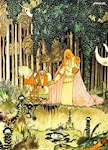Cover Art
The following quotes are from the essay, The Child and the Shadow (1974), printed in Language of the Night: Essays on Fantasy and Science Fiction, Revised Edition (HarperCollins, c1989) by Ursula K. Le Guin
“The great fantasies, myths and tales are indeed like dreams: they speak from the unconscious to the unconscious, in the language of the unconscious—symbol and archetype. Though they use words, they work the way music does: they short-circuit verbal reasoning, and go straight to the thoughts that lie too deep to utter… They are profoundly meaningful, and usable—practical—in terms of ethics; of insight; of growth.”
~ Ursula K. Le Guin ~ from The Child and the Shadow (1974)
“Most great fantasies contain a very strong, striking moral dialectic, often expressed as a struggle between the Darkness and the Light. But that makes it sound simple, and the ethics of the unconscious—of the dream, the fantasy, the fairy tale—are not simple at all…
In the fairy tale, though there is no “right” and “wrong,” there is a different standard, which is perhaps best called “appropriateness.” Under no conditions can we say that it is morally right and ethically virtuous to push an old lady into a baking oven. But, under the conditions of fairy tale, in the language of the archetypes, we can say with perfect conviction that it may be appropriate to do so. Because, in those terms, the witch is not an old lady, nor is Gretel a little girl. Both are psychic factors, elements of the complex soul. Gretel is the archaic child-soul, innocent, defenseless; the witch is the archaic crone, the possessor and destroyer... And so on and so on. All explanations are partial. The archetype is inexhaustible. And children understand it as fully and surely as adults do—often more fully, because they haven’t got minds stuffed full of the one-sided, shadowless half-truths and conventional moralities of the collective consciousness.
Evil, then, appears in the fairy tale not as something diametrically opposed to good, but as inextricably involved in it, as in the yang-yin symbol. Neither is greater than the other, nor can human reason and virtue separate one from the other and choose between them. The hero or heroine is the one who sees what is appropriate to be done, because he or she sees the whole, which is greater than either evil or good. Their heroism is, in fact, their certainty. They do not act by rules; they simply know the way to go.”
~ Ursula K. Le Guin ~ from The Child and the Shadow (1974)
“Even in merely reading a fairy tale, we must let go our daylight convictions and trust ourselves to be guided by dark figures, in silence; and when we come back, it may be very hard to describe where we have been.”
~ Ursula K. Le Guin ~ from The Child and the Shadow (1974)
"It seems to me that the way you can speak absolutely honestly and factually to children about good and evil is to talk about the self-- the inner, the deepest self. That is something children can and do cope with; indeed, our job in growing up is to become ourselves... We need knowledge; we need self-knowledge. We need to see ourselves and the shadows we cast."
~ Ursula K. Le Guin ~ from The Child and the Shadow (1974)
~ ~ ~ ~ ~ ~ ~ ~ ~
As always, for a complete understanding of her ideas and concepts, Le Guin's essays should be read in their entirety. For more quotes and information about Ursula K. Le Guin, her writing and essay collections, and more about writing, please visit my companion site and here, and Ursula K Le Guin's web site.


